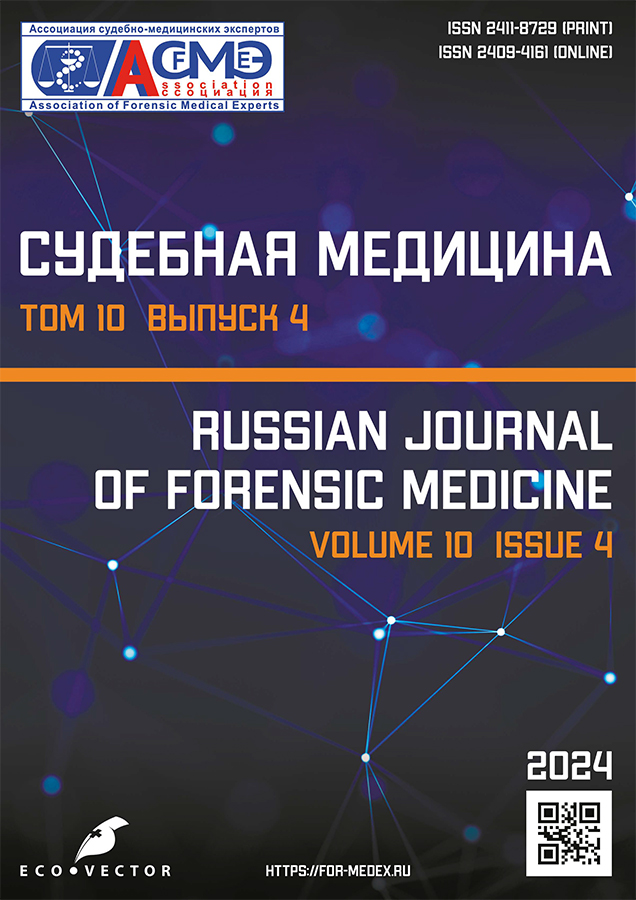Sudden death due to right fallopian tube tear in ectopic pregnancy: an autopsy-based case report
- Authors: Syahroni S.S.1, Ongko W.S.1, Yudianto A.1
-
Affiliations:
- Airlangga University
- Issue: Vol 10, No 4 (2024)
- Pages: 602-610
- Section: Case reports
- Submitted: 17.08.2024
- Accepted: 09.10.2024
- Published: 05.12.2024
- URL: https://for-medex.ru/jour/article/view/16180
- DOI: https://doi.org/10.17816/fm16180
- ID: 16180
Cite item
Abstract
Ectopic pregnancy complications, particularly those that cause rupture, can lead to sudden and critical situations. Sudden death cases should be approached as unnatural deaths until proven otherwise through scientific investigations. An autopsy is a key method conducted by a forensic and medicolegal pathologist for establishing the cause of death.
This case report presents a suspected case of unnatural death being investigated by the police. A young, unmarried woman living alone was found dead in her room, with no clear medical history. A forensic autopsy was performed to determine the cause of death. The findings revealed an enlarged uterus, a tear in the right fallopian tube, and a blood human chorionic gonadotropin level of 5,224.07 mIU/mL. Supported by histopathological findings through an overview that shows the existence of tubal ectopic pregnancy. Moreover, severe internal bleeding in the abdominal cavity due to a tear in the right fallopian tube was noted, which led to hemorrhagic shock caused by a 1,946.7 ml blood loss. Thus, the patient experienced multiple-organ failure, indicated by lung edema and kidney and stomach necrosis observed during a histopathological examination. The victim’s sudden death was a result of a natural cause, which was determined after eliminating other possibilities.
Full Text
About the authors
Syahroni S. Syahroni
Airlangga University
Author for correspondence.
Email: syahronibinmukin19@gmail.com
ORCID iD: 0000-0003-3058-146X
MD
Indonesia, СурабаяWira Santoso Ongko
Airlangga University
Email: wiraongko@gmail.com
ORCID iD: 0009-0006-1914-3986
MD
Indonesia, СурабаяAhmad Yudianto
Airlangga University
Email: yudi4n6sby@yahoo.co.id
ORCID iD: 0000-0003-4754-768X
MD, Dr. (Medicine), Professor
Indonesia, СурабаяReferences
- Risgaard B, Lynge TH, Wissenberg M, et al. Risk factors and causes of sudden noncardiac death: A nationwide cohort study in Denmark. Heart Rhythm. 2015;12(5):968–974. doi: 10.1016/j.hrthm.2015.01.024
- Saukko P, Knight B. Knight’s forensic pathology. 4th ed. New York, CRC press, Taylor and Francis Group; 2016. 666 р.
- Naneix AL, Périer MC, Beganton F, et al. Sudden adult death: An autopsy series of 534 cases with gender and control comparison. J Forensic Leg Med. 2015;32:10–15. doi: 10.1016/j.jflm.2015.02.005
- Chukus A, Tirada N, Restrepo R, Reddy NI. Uncommon implantation sites of ectopic pregnancy: Thinking beyond the complex adnexal mass. Radiographics. 2015;35(3):946–959. doi: 10.1148/rg.2015140202
- Lee R, Dupuis C, Chen B, et al. Diagnosing ectopic pregnancy in the emergency setting. Ultrasonography. 2018;37(1):78–87. doi: 10.14366/USG.17044
- Panelli DM, Phillips CH, Brady PC. Incidence, diagnosis and management of tubal and nontubal ectopic pregnancies: A review. Fertil Res Pract. 2015;(1):15. doi: 10.1186/s40738-015-0008-z
- Gaskins AJ, Missmer SA, Rich-Edwards JW, et al. Demographic, lifestyle, and reproductive risk factors for ectopic pregnancy. Fertil Steril. 2018;110(7):1328–1337. doi: 10.1016/j.fertnstert.2018.08.022
- Nugraha AR, Sa’adi A, Tirthaningsih NW. Profile study of ectopic pregnancy at Department of Obstetrics and Gynecology, Dr. Soetomo Hospital, Surabaya, Indonesia. Majalah Obstetri & Ginekologi. 2020;28(2):75. doi: 10.20473/mog.v28i22020.75-78
- Indrayanti S, Dharmayanti HE, Yusuf M. Management of abdominal pregnancy with placenta left in situ. Bali Med J. 2024;13(2):593–597. doi: 10.15562/bmj.v13i2.4927
- Mukti AF, Tunjungseto A. Successful management of an unruptured extrauterine pregnancy in a woman with a history of prior miscarriage in Indonesia: A case report. Indonesian Journal of Obstetrics and Gynecology. 2024;12(2):110–114. doi: 10.32771/inajog.v12i2.2111
- Cunningham FG, Leveno KJ, Bloom SL, et al. Williams obstetric 24/e. McGraw-Hill Education, McGraw-Hill Medical; 2014. 1376 р.
- Connolly AJ, Finkbeiner WE, Ursell PC, Davis RL. Autopsy pathology: A manual and atlas. 3rd ed. Elsevier Health Sciences; 2016. 400 р.
- Taran FA, Kagan KO, Hübner M, et al. The diagnosis and treatment of ectopic pregnancy. Dtsch Arztebl Int. 2015;112(41):693–704. doi: 10.3238/arztebl.2015.0693
- Sariroh W, Primariawan RY. Tingginya infeksi chlamydia trachomatis pada kerusakan tuba fallopi wanita infertil. Majalah Obstetri & Ginekologi. 2015;23(2):69–74. doi: 10.20473/mog.v23i2.2092
- Taghavi S, Nassar AK, Askari R. Hypovolemic shock. In: StatPearls [Internet]. Treasure Island (FL): StatPearls Publishing; 2023.
- Kennedy H, Haynes SL, Shelton CL. Maternal body weight and estimated circulating blood volume: A review and practical nonlinear approach. Br J Anaesth. 2022;129(5):716–725. doi: 10.1016/j.bja.2022.08.011
- Merrick C. Shock. In: ATLS: Advanced trauma life support. 10th ed. Student course manual. American College of Surgeons; 2018. Р. 48–50.
Supplementary files












